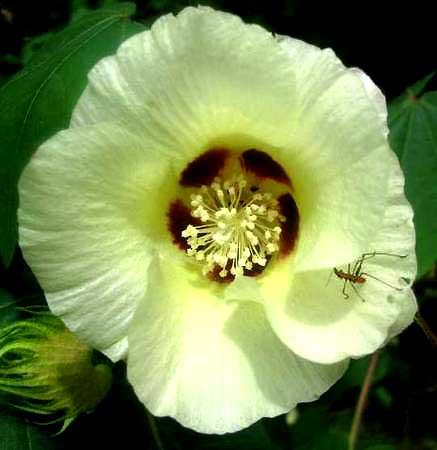
Sometimes during the dry season in villages you see leafless, shrubby bushes or small trees bearing what appear to be clusters of cotton fiber. Sometimes in rainy season the bushes bear leaves as well as cotton, as shown below.

If you are familiar with cotton grown in the US this plant might stump you, because you know that cotton grown up north is herbaceous, maybe around knee high, and these plants in the Yucatan are definitely woody and can reach ten feet (3m) or more.
Well, in the Yucatan we have two species often known as Tree Cotton: Gossypium hirsutum, often known as Upland Cotton, and Gossypium barbadense, sometimes called Sea-Island Cotton. I find Upland Cotton mostly planted in the areas I visit, and Sea-Island Cotton growing wild along the northern Yucatan's coast. Both of these "Tree Cottons" produces pretty, hibiscus-type flowers about two inches across (5cm) as shown below:

Flowers emerge as yellow but after pollination turn rose-purplish, so often you see blossoms of two different colors on the same branch. Something else fascinating about this plant is that often the fiber it produces is not pure white. Frequently it is beige or brownish. This is explained by Tree Cotton's history.
For, cotton was originally domesticated by indigenous people in the Andes. Moreover, the early domesticators seem to have been interested less in weaving textiles from cotton fiber than in making fishnets from them. And they knew that fish were more easily caught with dark nets than light ones, so they selected for plants producing dark fiber.
Eventually they had dark, chocolate-colored fiber. Of course once they had different strains of cotton producing different-hued fibers, then the production of multicolored textiles was sure to follow.
Fray Diego de Landa, in his 1566 book Relación de las Cosas de Yucatan, often mentions how the Maya, both before and after the Spaniards' arrival, slept under cotton blankets and in war wore cotton jackets as body armor. In Chapter 49 of Relación he writes that two kinds of cotton were planted: an annual dying after its first year and a small tree that produced cotton for five or six years.